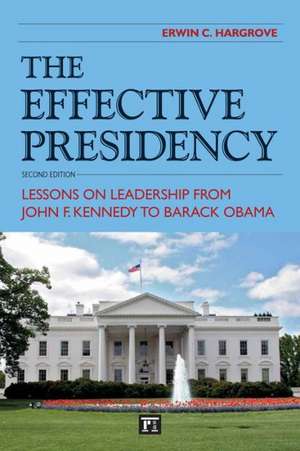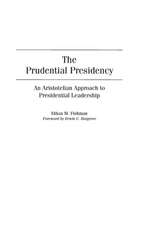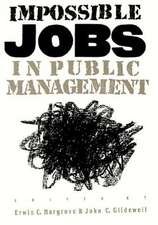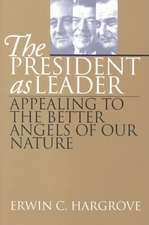Effective Presidency: Lessons on Leadership from John F. Kennedy to Barack Obama
Autor Erwin C. Hargroveen Limba Engleză Paperback – 30 ian 2014
Features of the textbook:
- Uses an analytical framework to assess historical context, personal skills and attributes, and the ability to "make a difference" in each of ten presidencies.
- Four presidents are judged to be "event-making" leaders: Johnson, Nixon, Reagan, and George W. Bush.
- Six presidents are assessed as "eventful" leaders: JFK, Ford, Carter, George H. W. Bush, Clinton, and Obama.
- As much a study of leadership as an analysis of ten presidencies, this book adds to our understanding in political science, history, and public administration and management.
| Toate formatele și edițiile | Preț | Express |
|---|---|---|
| Paperback (2) | 281.89 lei 6-8 săpt. | +21.78 lei 7-11 zile |
| Taylor & Francis – 30 ian 2014 | 371.47 lei 3-5 săpt. | +21.78 lei 7-11 zile |
| Taylor & Francis – 30 sep 2007 | 281.89 lei 6-8 săpt. | |
| Hardback (1) | 1221.26 lei 6-8 săpt. | |
| Taylor & Francis – 30 sep 2013 | 1221.26 lei 6-8 săpt. |
Preț: 371.47 lei
Nou
Puncte Express: 557
Preț estimativ în valută:
71.09€ • 77.19$ • 59.71£
71.09€ • 77.19$ • 59.71£
Carte disponibilă
Livrare economică 01-15 aprilie
Livrare express 18-22 martie pentru 31.77 lei
Preluare comenzi: 021 569.72.76
Specificații
ISBN-13: 9781612054346
ISBN-10: 161205434X
Pagini: 311
Dimensiuni: 152 x 229 x 18 mm
Greutate: 0.43 kg
Ediția:2
Editura: Taylor & Francis
Colecția Routledge
Locul publicării:Oxford, United Kingdom
ISBN-10: 161205434X
Pagini: 311
Dimensiuni: 152 x 229 x 18 mm
Greutate: 0.43 kg
Ediția:2
Editura: Taylor & Francis
Colecția Routledge
Locul publicării:Oxford, United Kingdom
Cuprins
Introduction: The Effective President
Chapter 1: John F. Kennedy: A Cautious Reformer
Chapter 2: Lyndon B. Johnson: A Force of Nature
Chapter 3: Richard M. Nixon: A Tragic Hero?
Chapter 4: Gerald R. Ford: A Good Man
Chapter 5: Jimmy Carter: The Engineer President
Chapter 6: Ronald Reagan: A Romantic with Vision
Chapter 7: George H. W. Bush: The Patrician
Chapter 8: Bill Clinton: The Politician
Chapter 9: George W. Bush: The Risk Taker
Chapter 10: Barack Obama: Transformational or Transactional Leader?
Conclusion: Presidential Leadership Revisited
Chapter 1: John F. Kennedy: A Cautious Reformer
Chapter 2: Lyndon B. Johnson: A Force of Nature
Chapter 3: Richard M. Nixon: A Tragic Hero?
Chapter 4: Gerald R. Ford: A Good Man
Chapter 5: Jimmy Carter: The Engineer President
Chapter 6: Ronald Reagan: A Romantic with Vision
Chapter 7: George H. W. Bush: The Patrician
Chapter 8: Bill Clinton: The Politician
Chapter 9: George W. Bush: The Risk Taker
Chapter 10: Barack Obama: Transformational or Transactional Leader?
Conclusion: Presidential Leadership Revisited
Recenzii
"Erwin Hargrove, already known as one of our greatest presidential historians, has given us a truly seminal, fascinating, and brilliant analysis of our last nine presidents from John F. Kennedy to George W. Bush, which is essential reading to understand modern American history. He provides a genuinely fresh way to measure these presidents, not by where they stand on the typical spectrum of great and near great to our worst presidents, but rather by their effectiveness in resolving national problems within the historical context they inherited. Indeed, by recognizing the dangers of presidents who seek greatness only to overreach and bring disasters upon the U.S. and the world, he sets clear standards for effectiveness. He sees four ‘event-making’ presidents since 1961, who have changed history, and five others who have been ‘eventful’, finding, ironically, that the former in many instances left a less positive legacy. His conclusion has a special message in today's world: ‘We need effective eventful presidents most of the time and should be suspicious to those presidents with ambitions to greatness.’ Many Americans would say ‘Amen’ to that finding."
—Stuart E. Eizenstat
Stuart E. Eizenstat was chief White House domestic policy adviser to President Jimmy Carter (1977-1981), and held a number of senior positions in the Clinton Administration, from US Ambassador to the European Union to Under Secretary of State to Deputy Secretary of the Treasury (1993-2001). He also served on the White House staff of President Lyndon B. Johnson (1967-1968).
“In this tightly written, jam-packed volume, a distinguished presidential scholar skillfully analyzes how and whether Kennedy through Bush 43 served effectively. Never shy about making judgments, Erwin C. Hargrove provides a stimulating, provocative, and comparative interpretation of the contributions of these nine presidents to a ‘healthy constitutional balance.’”
—Charles O. Jones, Hawkins Professor Emeritus of Political Science, University of Wisconsin-Madison
“Utilizing his considerable skills as both a storyteller and a political scientist, Erwin Hargrove reminds us that presidents who see themselves as heroes can be dangerous as well as heroic. Those who cope well with situations over which they have limited control do the day-to-day work a nation needs from a leader. This slim, conceptually rich book will be required reading for students of the presidency--and, one hopes, for would-be presidents.”
—Alonzo L. Hamby, Distinguished Professor of History, Ohio University
Praise for the first edition:
"Erwin Hargrove, already known as one of our greatest presidential historians, has given us a truly seminal, fascinating, and brilliant analysis of our last nine presidents from John F. Kennedy to George W. Bush, which is essential reading to understand modern American history. He provides a genuinely fresh way to measure these presidents, not by where they stand on the typical spectrum of great and near great to our worst presidents, but rather by their effectiveness in resolving national problems within the historical context they inherited. Indeed, by recognizing the dangers of presidents who seek greatness only to overreach and bring disasters upon the U.S. and the world, he sets clear standards for effectiveness. He sees four 'event-making' presidents since 1961, who have changed history, and five others who have been 'eventful,' finding, ironically, that the former in many instances left a less positive legacy. His conclusion has a special message in today's world: 'We need effective eventful presidents most of the time and should be suspicious to those presidents with ambitions to greatness.' Many Americans would say 'Amen' to that finding."
-- Stuart E. Eizenstat, Presidential adviser to LBJ, Jimmy Carter, and Bill Clinton
"In this tightly written, jam-packed volume, a distinguished presidential scholar skillfully analyzes how and whether Kennedy through Bush 43 served effectively. Never shy about making judgments, Erwin C. Hargrove provides a stimulating, provocative, and comparative interpretation of the contributions of these nine presidents to a 'healthy constitutional balance.'"
-- Charles O. Jones, Hawkins Professor Emeritus of Political Science, University of Wisconsin—Madison
"Utilizing his considerable skills as both a storyteller and a political scientist, Erwin Hargrove reminds us that presidents who see themselves as heroes can be dangerous as well as heroic. Those who cope well with situations over which they have limited control do the day-to-day work a nation needs from a leader. This slim, conceptually rich book will be required reading for students of the presidency -- and, one hopes, for would-be presidents."
-- Alonzo L. Hamby, Distinguished Professor of History, Ohio University
—Stuart E. Eizenstat
Stuart E. Eizenstat was chief White House domestic policy adviser to President Jimmy Carter (1977-1981), and held a number of senior positions in the Clinton Administration, from US Ambassador to the European Union to Under Secretary of State to Deputy Secretary of the Treasury (1993-2001). He also served on the White House staff of President Lyndon B. Johnson (1967-1968).
“In this tightly written, jam-packed volume, a distinguished presidential scholar skillfully analyzes how and whether Kennedy through Bush 43 served effectively. Never shy about making judgments, Erwin C. Hargrove provides a stimulating, provocative, and comparative interpretation of the contributions of these nine presidents to a ‘healthy constitutional balance.’”
—Charles O. Jones, Hawkins Professor Emeritus of Political Science, University of Wisconsin-Madison
“Utilizing his considerable skills as both a storyteller and a political scientist, Erwin Hargrove reminds us that presidents who see themselves as heroes can be dangerous as well as heroic. Those who cope well with situations over which they have limited control do the day-to-day work a nation needs from a leader. This slim, conceptually rich book will be required reading for students of the presidency--and, one hopes, for would-be presidents.”
—Alonzo L. Hamby, Distinguished Professor of History, Ohio University
Praise for the first edition:
"Erwin Hargrove, already known as one of our greatest presidential historians, has given us a truly seminal, fascinating, and brilliant analysis of our last nine presidents from John F. Kennedy to George W. Bush, which is essential reading to understand modern American history. He provides a genuinely fresh way to measure these presidents, not by where they stand on the typical spectrum of great and near great to our worst presidents, but rather by their effectiveness in resolving national problems within the historical context they inherited. Indeed, by recognizing the dangers of presidents who seek greatness only to overreach and bring disasters upon the U.S. and the world, he sets clear standards for effectiveness. He sees four 'event-making' presidents since 1961, who have changed history, and five others who have been 'eventful,' finding, ironically, that the former in many instances left a less positive legacy. His conclusion has a special message in today's world: 'We need effective eventful presidents most of the time and should be suspicious to those presidents with ambitions to greatness.' Many Americans would say 'Amen' to that finding."
-- Stuart E. Eizenstat, Presidential adviser to LBJ, Jimmy Carter, and Bill Clinton
"In this tightly written, jam-packed volume, a distinguished presidential scholar skillfully analyzes how and whether Kennedy through Bush 43 served effectively. Never shy about making judgments, Erwin C. Hargrove provides a stimulating, provocative, and comparative interpretation of the contributions of these nine presidents to a 'healthy constitutional balance.'"
-- Charles O. Jones, Hawkins Professor Emeritus of Political Science, University of Wisconsin—Madison
"Utilizing his considerable skills as both a storyteller and a political scientist, Erwin Hargrove reminds us that presidents who see themselves as heroes can be dangerous as well as heroic. Those who cope well with situations over which they have limited control do the day-to-day work a nation needs from a leader. This slim, conceptually rich book will be required reading for students of the presidency -- and, one hopes, for would-be presidents."
-- Alonzo L. Hamby, Distinguished Professor of History, Ohio University
Descriere
Presidential scholar Erwin Hargrove extends his analytical framework of presidential effectiveness to show how Obama combines eventful leadership with pragmatism in moving forward in an intensely polarized partisan environment. Reviewing eventful and event-making presidencies of the last 50 years, Hargrove comes down on the side of effectiveness over the special effects of the pyrotechnic presidencies of the past.
Notă biografică
Erwin C. Hargrove is Professor Emeritus of Political Science at Vanderbilt University and winner of the prestigious Richard E. Neustadt Award. Among his many books are The President as Leader: Appealing to the Better Angels of Our Nature (University Press of Kansas 1999) and Jimmy Carter as President: Leadership and the Politics of the Public Good (Louisiana State University Press 1988.)








